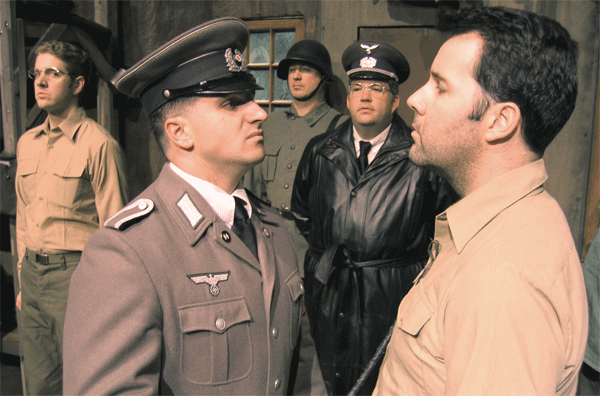|
OC REGISTER, Thursday, November 2th, 2005
CAST LIBERATES ‘STALAG 17’
Fullerton staging adds authenticity to 1951 script’s laughs and suspense
.
By ERIC MARCHESE
The stage version of the 1953 film “Stalag 17,” most would assume, is based on the film – but it’s the play that came first.
Most might also argue the famed film, directed by Billy Wilder and starring William Holden, is more effective. Donald Bevan and Edward Trzcinski’s 1951 play, though, has a certain undeniable appeal in its portrait of American soldiers in a German POW camp in 1944, trying to cope with boredom, loneliness for home and uncertainty about their fate.
There’s also the little matter of the German agent in their midst, passing along prisoner escape plans and other vital information to the camp commandant. The play generates suspense through two basic questions: Will the men learn the mole’s identity, and what how they react if they do?
At Fullerton’s Maverick Theater, Brian Newell’s Staged Cinema production rises to the script’s many challenges, which include handling the revelations regarding the spy’s identity, switching back and forth between the POW barracks and the outdoor yard area, and an ending that will probably strike many viewers as more than just a little abrupt. Newell’s knowing handling of the material and his solid casting are good starts; so are his ingenious, flexible set and use of well-known movie scores, such as Elmer Bernstein’s “The Great Escape” theme, as incidental music.
The tension builds almost from the get-go, as barracks chief Herman Hoffy (Frank Tryon) assigns Price (Brady Miller), his security officer, to the task of ferreting out the mole. The obvious suspect is Sefton (Nick Boicourt), a loner who exchanges cigarettes for goods, favors and information with Corporal Shultz (Barney Evans). Sefton bitterly resents the accusation, insisting he’s being made the scapegoat.
Newell’s staging, co-directed by Jax DiBenedetto, nicely communicates the humor and pathos of the POWs’ day-to-day existence. These are men’s men who can dance with each other in their longjohns without feeling self-conscious, who play cards and chess and talk about home to tamp down the sanity-killing boredom.
Boicourt is a coolheaded and pragmatic Sefton, the Holden role; chomping a cigar, wearing a Boston Red Sox cap, he withstands his peers’ scorn, asserting that every POW barters with the guards and that “it’s every man for himself.”
Tryon’s Hoffy is decent and fair. Miller is a thin, bespectacled, well-spoken, clean-cut Price. As best buds Harry and Stosh, Steven Lamprinos and Chris Goss are credibly colorful and outspoken. Goss’ resemblance to Kiefer Sutherland means his character isn’t especially grungy, but Stosh’s animosity toward Sefton is never far from the surface.
Evan Harris effortlessly tosses off impressions of Hollywood stars Bogie, John Wayne, Bela Lugosi and more as entertaining joker Reed, a would-be actor. Kevin Moynahan is surprisingly regular-guy as the Boston blueblood Dunbar. Nathan Mararyk’s Herb is sunny and positive, and Steve Walker’s mail clerk Marko is like a New York-style Radar O’Reilly.
Evans’ pudgy Shultz pokes fun at the captives, never putting too much stock in their antics. In his spiffy uniform, Brian Schmidt’s brittle S.S. Captain is alternately vicious and supercilious, and in Ryan Joseph and Stephen Sands, Newell has two frighteningly grim Nazi guards.
Newell’s barracks set and Heidi Newell’s costumes have a grimy, lived-in look and Makaryk’s carpentry and Jim Book’s technical and lighting effects add authenticity – but it’s the way the cast essays the story’s characters that set this “Stalag 17” free.
|